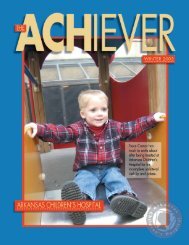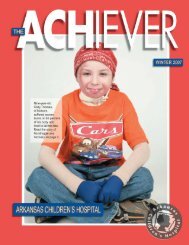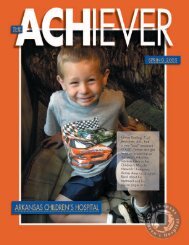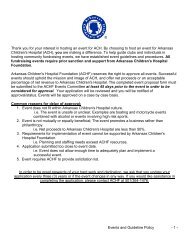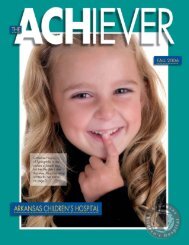Winter 2008 - Arkansas Children's Hospital
Winter 2008 - Arkansas Children's Hospital
Winter 2008 - Arkansas Children's Hospital
- No tags were found...
Create successful ePaper yourself
Turn your PDF publications into a flip-book with our unique Google optimized e-Paper software.
RESEARCHStrengthening the Case AgainstPregnancyandSmoking■ John GreganEach year in the United States, an estimated 36,000 infants areborn with a heart defect. During the first year of life, approximatelyone in four of these infants requires invasive medical and/or surgicaltreatment, and one in eight will die.Maternal smoking is known to increase the risk of prematurity,low birth weight and cleft palate in babies. At the <strong>Arkansas</strong>Children’s <strong>Hospital</strong> Research Institute (ACHRI), Dr. Sadia Malik, apediatric cardiologist and public health specialist, is investigating theassociation between congenital heart defects and maternal smokingand/or exposure to passive smoking.Under a two-year grant from the National Institute of ChildHealth and Human Development (NICHD), Dr. Malik is examiningnicotine levels in the hair of 50 mothers of infants with congenitalheart defects and 50 mothers of infants with no birth defects. “Theheart forms in the first trimester, and mothers may be smoking orexposed to cigarette smoke before they know they’re pregnant,” saysDr. Malik.The goal of the study is to measure nicotine exposures duringearly stages of pregnancy and the formation and development ofthe embryo that may be associated with adverse outcomes such asheart defects.To measure exposure to nicotine during the period correspondingto the first trimester of pregnancy, participants in Dr. Malik’s studyare providing 10 centimeters of hair after their infants are born. Incollaboration with researchers in California and New Zealand, hairsamples are analyzed in such a way as to determine the exact timingof exposure to nicotine. The hair shaft provides a “journal” of nicotineexposure during pregnancy. If hair nicotine levels correspondingto key periods of heart development are higher in mothers ofinfants with congenital heart disease, this will provide evidence thattobacco exposure may be causally related to congenital heart disease.The majority of congenital heart defects require only a visit to thepediatric cardiologist for diagnostic tests, such as an echocardiogramand medication; however, some heart defects require multiple surgeriesand may result in lifelong limitations in daily activities or even indeath. Heart defects range from simple problems, such as “holes”between the chambers of the heart, to severe malformations, such asvery small heart chambers or valves.“I want to help find a cure for the cause of these heart problemsso other families don’t have to go through what we’re goingBettye Flowers, RN, collects a hair sample from a non-smokingmother of a child with a heart defect participating in astudy at <strong>Arkansas</strong> Children’s <strong>Hospital</strong> Research Institute.through,” says Amanda, a non-smoking mother of a child with a heartdefect participating in Dr. Malik’s study. Getting her hair clipped forthe study, Amanda adds, “I want to get the word out about what causesthese problems.”It is important that physicians and patients are aware of all thedetrimental effects of maternal smoking on the developing fetus sowomen can make informed lifestyle decisions prior to becoming pregnant.Twenty-eight percent of <strong>Arkansas</strong> women smoke, and 20 percentcontinue to smoke during pregnancy. Nationally, 25 percent ofwomen smoke, and 12 percent continue while pregnant. The results ofDr. Malik’s study may provide evidence that will compel some womento stop smoking during their reproductive years.“Both active and passive exposure to tobacco smoke has a longlegacy of association with harmful health events. Although many ofthese effects have been proven in the person who smokes, identifyingthe many harmful effects of environmental tobacco exposure on thefetus, newborn and children continues to challenge researchers,” saysACHRI president Dr. Richard Jacobs*. “Our research group atACHRI, with Dr. Sadia Malik’s leadership, is investigating the potentiallink between environmental tobacco exposure and congenital heartdisease. We are very excited about this project and its potential toadvance our understanding of this important potential association.”This study complements Dr. Malik’s other research funded by the<strong>Arkansas</strong> Biosciences Institute, the major research component of theTobacco Settlement Proceeds Act of 2000. She also receives fundingfrom the American Heart Association’s Heartland Affiliate BeginningGrant-in-Aid Program, which promotes the independent status ofpromising new scientists in research related to cardiovascular functionand disease.*Sadia Malik, M.D., M.P.H., is a pediatric cardiologist at ACH andassistant professor of pediatrics, UAMS College of Medicine*Richard F. Jacobs, M.D., FAAP, is president of ACHRI, professor ofpediatrics and chairman of the department of pediatrics, UAMSCollege of Medicine.9




